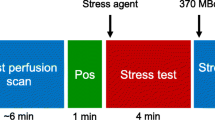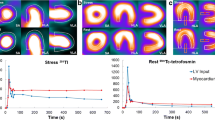Abstract
Objective
A mismatch defect between 201TL and 123I-BMIPP dual isotope SPECT (d-SPECT) is useful to detect myocardial ischemia in patients with acute coronary syndrome. However, whether mismatched d-SPECT findings reflect actual myocardial ischemia in stable patients with suspected, but unknown ischemic heart disease is unclear. The present study assesses the significance of a d-SPECT mismatch among such patients.
Methods
Forty-nine patients with suspected stable coronary heart disease who had been referred for chest pain, ECG abnormalities or multiple risk factors (66 ± 11 years old, 34 males) with a d-SPECT mismatch participated in this study. All of them underwent coronary angiography (CAG) to assess coronary artery disease. The entire myocardial area on d-SPECT images was divided into 17 segments, each of which was scored from 0 (normal) to 4 (defect). The d-SPECT mismatch score (MS) was defined as the summed BMIPP defect score (BM-TDS) minus the summed defect score (TL-TDS). The inclusion criterion was MS ≥ 1, and the mismatch was defined as true positive if the mismatched area was concordant with the territories supplied by significant coronary stenotic arteries by CAG.
Results
Ischemic heart disease was judged by coronary angiography in 31 (63%) patients (IHD group), of which 24 (49.0%) were true positives. Of the remaining 18 (37%) patients without no significant coronary stenosis (non-IHD group), 12 (24%) had some types of organic heart disease. If MS ≥ 4 was defined as the threshold for an ischemic positive mismatch, then the sensitivity and specificity were 80% and 63%, respectively. However, mismatch scores did not significantly differ between the groups with true positive-IHD and organic heart disease in non-IHD group (6.6 ± 4.4 vs. 6.4 ± 3.7).
Conclusion
A d-SPECT mismatch score of ≥4 was an appropriate cutoff at which diagnosis of myocardial ischemia in patients who were screened for ischemic heart disease. However, since patients with non-ischemic but organic heart disease can also present with abnormal mismatch findings, coronary angiography or CT might be warranted to differentiate IHD from non-IHD.





Similar content being viewed by others
References
Kawai Y, Tsukamoto E, Nozaki Y, Morita K, Sakurai M, Tamaki N. Significance of reduced uptake of iodinated fatty acid analogue for the evaluation of patients with acute chest pain. J Am Coll Cardiol. 2001;38:1888–94.
Taki J, Matsunari I, Nakajima K, Tonami N. BMIPP compared with thallium redistribution. Int J Card Imaging. 1999;15:49–59.
Yamabe H, Fujiwara S, Rin K, Ando M, Yokoyama M, Sakamoro T, et al. Resting 123I-BMIPP scintigraphy for detection of organic coronary stenosis and therapeutic outcome in patients with chest pain. Ann Nucl Med. 2000;14:187–92.
Ueshima K, Miyakawa T, Taniguchi Y, Nishiyama O, Musha T, Saitoh M, et al. The incidence of discrepant regional myocardial uptake between 201 thallium and 123 I-BMIPP SPECT in patients with coronary heart disease. Int J Cardiovasc Imaging. 2002;18:273–8.
Cerqueira MD, Weissman NJ, Dilsizian V, Jacobs AK, Kaul S, Laskey WK, et al. Standardized myocardial segmentation and nomenclature for tomographic imaging of the heart: a statement for healthcare professionals from the Cardiac Imaging Committee of the Council on Clinical Cardiology of the American Heart Association. Circulation. 2002;105:539–42.
Taki J, Nakajima K, Bunko H, Shimizu M, Taniguchi M, Hisada K. 123I-labelled BMIPP fatty acid myocardial scintigraphy in patients with hypertropic cardiomyopathy: SPECT comparison with stress 201Tl. Nucl Med Commun. 1993;14:181–8.
Ito T, Hoshida S, Nishino M, Aoi T, Egami Y, Takeda T, et al. Relationship between evaluation by quantitative fatty acid myocardial scintigraphy and response to beta-blockade therapy in patients with dilated cardiomyopathy. Eur J Nucl Med. 2001;28:1811–6.
Le Guludec D, Menad F, Faraggi M, Weinmann P, Battesti JP, Valeyre D. Myocardial sarcoidosis. Clinical value of technetium-99 m sestamibi tomoscintigraphy. Chest. 1994;106:1675–82.
Tellier P, Paycha F, Antony I, Nitenberg A, Valeyre D, Foult JM, et al. Reversibility by dipyridamole of thallium-201 myocardial scan defects in patients with sarcoidosis. Am J Med. 1988;85:189–93.
Shikama N, Nakagawa T, Takiguchi Y, Aotsuka N, Kuwabara Y, Komiyama N, et al. Assessment of myocardial perfusion and fatty acid metabolism in a patient with Churg-Strauss syndrome associated with eosinophilic heart disease. Circ J. 2004;68:595–8.
Sitia S, Atzeni F, Sarzi-Puttini P, Di Bello V, Tomasoni L, Delfino L, et al. Cardiovascular involvement in systemic autoimmune diseases. Autoimmun Rev. 2009;8:281–6.
Author information
Authors and Affiliations
Corresponding author
Rights and permissions
About this article
Cite this article
Nakamura, A., Momose, M., Kondo, C. et al. Ability of 201Tl and 123I-BMIPP mismatch to diagnose myocardial ischemia in patients with suspected coronary artery disease. Ann Nucl Med 23, 793–798 (2009). https://doi.org/10.1007/s12149-009-0307-8
Received:
Accepted:
Published:
Issue Date:
DOI: https://doi.org/10.1007/s12149-009-0307-8




